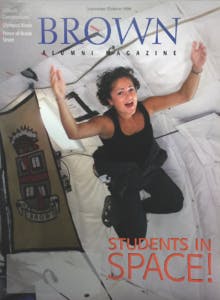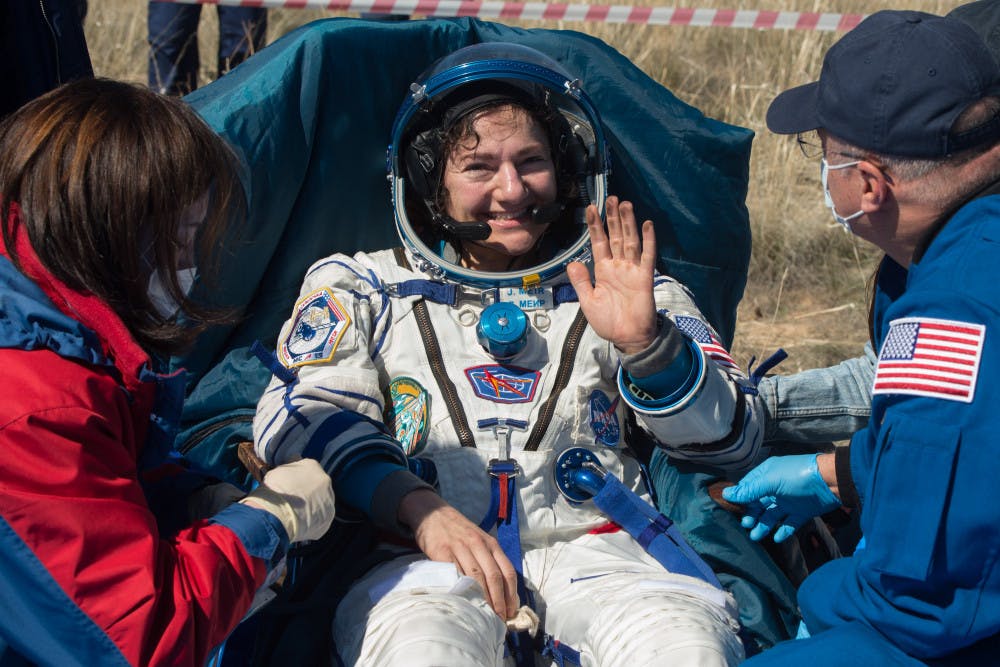Jessica Meir ’99 returned to Earth’s surface Friday at 1:16 am EDT, marking the end of her 205th day in space.
The landing was live-streamed on NASA’s website as Thursday night gave way to Friday morning on the East coast. At 6:44 pm EDT, Meir, fellow NASA astronaut Andrew Morgan and Roscosmo Oleg Skripochka hugged the remaining astronauts aboard the ISS goodbye, climbing into the Soyuz ship and closing the hatch behind them. By 9:53 pm EDT, Meir gave the undocking command and the MS-15 Soyuz ship disassociated from the ISS.
Landing and return to life on Earth
The ship that brought the trio back to Earth had been parked at the ISS since Meir and Skirpochka arrived together on September 25. Meir was the second in command, while Oleg Skripochka was in command of the ship, according to the live stream.
At 12:22 am EDT, the ship’s “deorbit burn” took place, slowing the ship as it began to transition out of Earth’s orbit and back into the atmosphere. As the ship passed through the atmosphere, the astronauts felt five times the force of gravity on Earth during one period of the flight.
At 1:02 am, the ship’s parachutes opened and at 1:08 am it was reported to be visible from the ground. The crew reported “feeling well” to mission control throughout the final descent.
[caption id="" align="aligncenter" width="605"]
By 1:16 am ET and 11:16 am Kazakhstan time, the ship had reached the landing site within the desolate Kazakh steppes, reportedly touching down on its side. Meir and crew were then extracted from the ship by Russian rescue officials. NASA was unable to stream live landing footage but did capture the astronaut’s extraction from the ship and first breaths of fresh air.
The only sign of the looming COVID-19 crisis was the precautionary masks, gloves and other forms of PPE donned by the rescue officials. After being extracted, NASA flight doctors did a post-flight medical check on Meir and Morgan as they sat in chairs, calibrating their bodies to the force of Earth’s gravity and sporting sunglasses to shield their eyes from the bright rays of the sun.
Before departing, Meir reflected on the alterations to typical landing protocol in light of COVID-19 in a conversation with David Greene of National Public Radio’s Morning Edition for a segment that aired Thursday.
“Our support people on the ground have been working very hard to figure out even how to pick us up.” Usually, Meir explained, NASA would fly returning astronauts back to Houston within 24 hours of their reentry. Due to international travel restrictions, their travels back to the U.S. will be more complicated.
“It’s going to be kind of like a planes, trains, and automobiles scenario,” she said on NPR, adding, “I think we will even be riding in an ambulance for several hours across the Kazakh Steppe in order to get to our airplane.”
Even as much of the world remains in quarantine, the astronauts will have to endure a unique period of isolation as they acclimate back to life on Earth. “One of the hallmarks of space flight, physiologically, is actually a dysregulation of our immune system. We can come back a bit immunocompromised,” she told Greene. The returning astronauts will be subject to a strict quarantine in the U.S. and will live at NASA headquarters for at least a week with limited access, Meir told NPR, before they are able to return to their own homes.
The Brown community welcomes Meir home
In the days preceding Meir’s journey home, The Herald checked in with Brown community members whom Meir has cited as integral to her journey from Brown to the ISS.
“Having worked in the training of the NASA astronauts from the Apollo lunar astronauts onward to today, I can say that Brown graduate and NASA Astronaut Jessica Meir is absolutely tops!” Distinguished Professor of Geologic Sciences Jim Head wrote in an email to The Herald. “She is extremely bright, dedicated, well-versed in a variety of critical disciplines, a great team player, and focused on her mission,” he added. Head has served as an instructor for every one of NASA’s astronaut classes, including Meir’s beginning in 2013 since he worked at NASA from 1968 to 1973 during the APOLLO 7-17 Lunar Exploration program.
According to Head, Meir received one of the best grades ever recorded in his class GEOL 0050: “Mars, the Moon and the Earth,” when she was an undergraduate. “It was a great pleasure to have her in class at Brown, encourage her on her quest to be an Astronaut while at Brown, and work with her at NASA once she was accepted into the NASA Astronaut Corps,” he wrote. The class, now taught by Professor of Earth, Environmental and Planetary Sciences John Mustard, is still popular at the University; over 100 undergraduates enrolled last Fall, according to Courses@Brown.
Professor of Biology Kenneth Miller taught the introductory Biology class that set Meir on her path as a Biology concentrator at the University, and still teaches BIOL 0200: “The Foundation of Living Systems.” “Every time I see one of our graduates accept a challenge, whether it's a journey to space, medical work on the front lines of a pandemic, or an unsolved research problem, I think it sends a message,” Miller wrote in an email to The Herald. “Jessica is an extraordinary example among the many students who have left Brown and risen to meet extraordinary challenges.”
“Jessica's career path shows that a Biology concentration prepares you for a variety of possibilities,” he added.
When Meir was studying Biology at Brown, she did research in Professor Emeritus of Pathology and Laboratory Medicine Herman Vandenburgh’s lab, where Peter Lee '94 PhD'03 MD'05 was a graduate student. They collaborated on the experiment that brought Meir to NASA’s reduced gravity aircraft “the vomit comet” — which put Meir on the cover of the Brown Alumni Magazine only a few months after she had graduated in 1999. Lee and Meir also both earned their Masters in Space Studies at the International Space University in France. Last month, Meir did an experiment on the ISS that Lee co-lead from the ground, The Herald previously reported.
[caption id="" align="alignleft" width="322"]
The experiment was designed to test the effect of spaceflight on tissue-engineered heart muscle. “It was serendipitous that Jessica was up there and with her biology background, she was a natural person to be taking care of our tissues,” Lee told The Herald.
“NASA clearly wanted a first-rate Biologist on the mission, and that's exactly what they found in her. She's done an incredible job of moving some key experiments forward,” Miller wrote.
And while most research around the world, and at the University, has been put on hold in the wake of COVID-19, science aboard the ISS — being conducted miles above the pandemic — was able to operate relatively normally. The tissue-engineered heart muscle launched to the space station from the Kennedy Space Center in Florida before the pandemic escalated, and now a small group of investigators is safely managing the corresponding controls on the ground for the experiment, Lee said. On the ground, “we've had to be a little more creative in terms of some aspects that require in-person activities,” Lee said.
In terms of future missions, Head wrote that the Department of Earth, Environmental and Planetary science is currently “working very hard on the NASA ARTEMIS Lunar Exploration Program, which will land the ‘first woman and next man on the lunar surface’ to continue important scientific exploration already underway robotically.”
Head added: “It is very clear to me that (Meir) is a prime candidate to be that ‘first woman’ on the Moon and I look forward to tracking her trajectory toward that goal.”
One day, Meir may feel the Moon’s rocky surface below her feet. But for now, she is again subject to the familiar force of Earth’s gravitational pull.

ADVERTISEMENT




